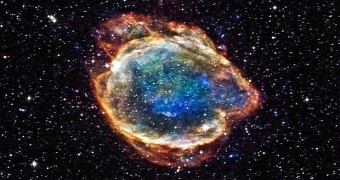Just yesterday, scientists with NASA released a new and positively stunning image of an exploded star. The image, featured next to this article, was obtained with the help of the space agency's Chandra X-ray Observatory.
Probably because they are feeling a tad poetic these days, astronomers say that this exploded star looks like a blooming cosmic flower, what with its roundish shape and its pretty colors. Truth be told, it kind of does.
Introducing supernova remnant G299.2-2.9
As detailed by NASA researchers, the torn-apart star shown in this Chandra X-ray Observatory image goes by the name of G299.2-2.9. Every once in a while, it is referred to simply as G299.
True, these monikers are not all that poetic and, consequently, not exactly fit for a blooming cosmic flower. Then again, as Juliet taught us, a rose by any other name would smell as sweet or, in this case, look as stunning.
Mind you, this supernova remnant does not really shine in red, green and blue when observed with the naked eye. Thus, these three colors in the image detailing its anatomy stand for low, medium and high-energy X-rays, respectively.
Astronomers explain that the medium energy X-rays shown in this image include emission from iron. The high-energy X-rays, on the other hand, include emission from silicon and sulfur.
This cosmic flower was created by a so-called Type Ia supernova. Such explosions occur when a white dwarf star draws material from a Sun-like companion and then self-destructs or when two white dwarf stars merge.
An unusual shape for an exploded star
Unlike other exploded stars researchers have until now had the chance to study, G299.2-2.9 is not symmetric. On the contrary, the debris that went flying through the cosmos when the star exploded failed to form a perfect sphere.
Instead, it expanded in rather random directions, forming the unusual structures that scientists say bear a striking resemblance to flower petals. Chances are that the debris did not expand symmetrically because it encountered bumps on its way.
“Traditional theoretical models of Type Ia supernovas generally predict that these explosions would be symmetric, creating a near perfect sphere as they expand. It might be that the remnant has been expanding into an environment where the medium it encountered was uneven,” scientists say.
In case anyone was wondering, this supernova remnant is located at a distance of about 16,000 light-years from our planet. Astronomers estimate that the star that birthed it exploded about 4,500 years ago.

 14 DAY TRIAL //
14 DAY TRIAL //